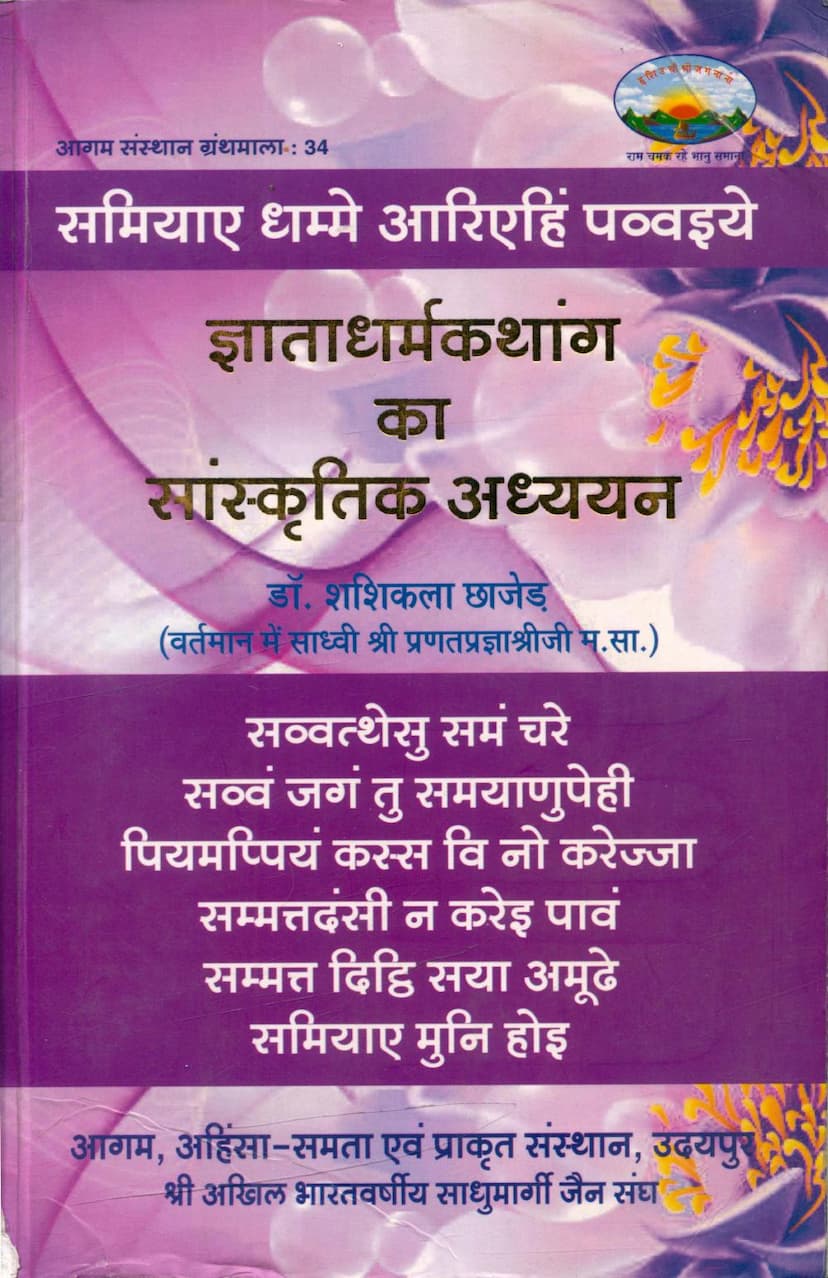Gnatadharm Kathang Ka Sanskritik Adhyayan
Added to library: September 1, 2025

Summary
Here's a comprehensive summary of the Jain text "Gnatadharm Kathang Ka Sanskritik Adhyayan" by Shashikala Chhajed, based on the provided pages:
Book Title: Gnatadharm Kathang Ka Sanskritik Adhyayan (A Cultural Study of Gnatadharmkathanga) Author: Dr. Shashikala Chhajed (Currently Sadhvi Shri Pranat Pragya Shri Ji M.S.) Publisher: Agam, Ahimsa-Samta evam Prakrit Sansthan, Udaipur, in association with Shri Akhil Bharatvarshiya Sadhumargi Jain Sangh.
Overview:
This book is a comprehensive cultural study of the Gnatadharmkathanga, the sixth Anga (limb) of the Shvetambara Jain Agamas. The author, Dr. Shashikala Chhajed (now Sadhvi Shri Pranat Pragya Shri Ji M.S.), originally wrote this as a doctoral dissertation at Jain Vishva Bharati Institute, Ladnun, for which she was awarded a Ph.D. in 2004. The publisher, Agam, Ahimsa-Samta evam Prakrit Sansthan, recognized the value of this research for the general public and decided to publish it to make the vast knowledge contained within Jain Agamas accessible to Jain followers, scholars, and young academics.
Content and Structure:
The book is meticulously structured into nine chapters, each delving into a specific aspect of the cultural landscape depicted in the Gnatadharmkathanga. The author's intent is to reveal the traditional insights preserved within the text.
The nine chapters are:
- Jain Agam and Gnatadharmkathanga: This introductory chapter clarifies the meaning, etymology, and definitions of "Agam," discusses its different recensions (vachanas), its classification, and provides a brief overview of the Gnatadharmkathanga's place within the Dwadashangi (the twelve Angas).
- Elements of Culture and Gnatadharmkathanga: This chapter analyzes the prevailing culture of the period by examining the meaning, etymology, definitions, and elements of "culture" itself.
- Geographical Analysis of Gnatadharmkathanga: This chapter details the geographical landscape described in the text, including descriptions of countries, cities, mountains, rivers, gardens, forests, and vegetation.
- Social Life in Gnatadharmkathanga: This chapter explores the social conditions of the time, discussing family structures, behavior, customs, attire, festivals, folk beliefs, superstitions, social evils, the caste system (Varna Vyavastha), and the system of life stages (Ashrama Vyavastha).
- Economic Life in Gnatadharmkathanga: This chapter examines the economic conditions through topics like agriculture, irrigation, tools, security, cultivation, harvesting, storage, animal husbandry, capital and money lending, crafts, industries (textile, metal, pottery, wood, painting, leather, alcohol, construction, cosmetics, sugar, cottage industries), trade, transport, and means of livelihood like warfare, writing, and agriculture, as well as measures, weights, and currency.
- Political Situation in Gnatadharmkathanga: This chapter focuses on the political structure, describing the king, his nature, qualities, rights, duties, the nature of the state, administrative systems, state officials, sources of income and expenditure, military organization, rules of warfare, weaponry, and other military equipment.
- Education in Gnatadharmkathanga: This chapter analyzes the educational system of the era, covering the meaning, definition, nature, goals of education, teaching and learning processes, subjects of study, qualities and types of teachers, the importance of gurus, student qualifications and disqualifications, teacher-student relationships, disciplinary systems, and educational institutions.
- Art in Gnatadharmkathanga: This chapter provides an insight into the arts of the period, explaining the etymology, meaning, and definitions of "art," its elements, types, and its influence on life.
- Religion and Philosophy in Gnatadharmkathanga: This final chapter provides a comprehensive analysis of the religion and philosophy presented in the Gnatadharmkathanga, focusing on metaphysics, epistemology, ethics, and the philosophy of action (karma), while also touching upon non-Jain religious philosophies prevalent at the time.
The book concludes with an "Upasamhar" (Conclusion) that highlights the importance and utility of the work.
Author's Journey:
The author's dedication is further highlighted by her spiritual journey. After completing her research, she embraced Jain Diksha (ascetic initiation) on January 28, 2007, from Acharya Shri Ramlal Ji M.S., taking the name Sadhvi Shri Dhanashriji M.S. (currently Sadhvi Shri Pranat Pragya Shri Ji M.S.). Her mother also took Diksha alongside her.
Publisher's Vision:
The publishing institution aims to bring the extensive knowledge of Jain Agamas to a wider audience, fostering awareness among lay followers, researchers, and young scholars interested in Jain religion and philosophy. They have already published 33 books related to Jainism. The publication of this work was made possible through the generous support of Mrs. Maghi Devi, wife of the late Shri Mohanlal Ji Dugad.
Cultural Significance of Gnatadharmkathanga:
The Gnatadharmkathanga is recognized for its rich narrative style, which uses stories, parables, and analogies to illustrate Jain philosophical concepts and to depict the socio-cultural life of ancient India. It offers valuable insights into the customs, beliefs, economic activities, political structures, educational practices, and artistic expressions of the time, making it an invaluable resource for understanding ancient Indian civilization through a Jain lens. The book's detailed analysis across nine chapters underscores the multifaceted cultural tapestry woven into this significant Jain scripture.